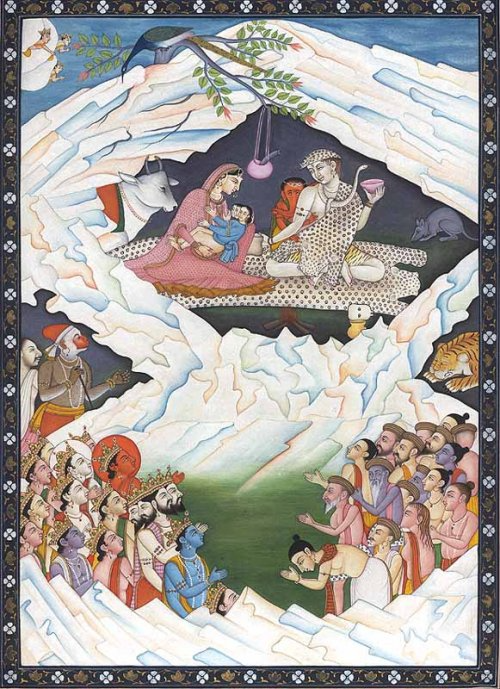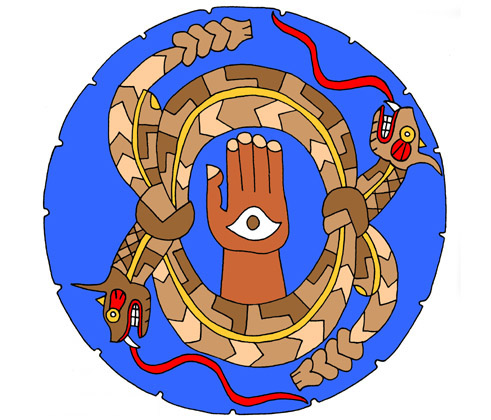The Spike is the central pillar that holds up the sky and unites Sky, Air, Earth, Water, and Darkness. It extends from the deepest depths of the Underworld to the City atop the Sky Dome. The destruction of the Spike is the worst moment of the Greater Darkness, and marks when the relationship between gods and mortals changed forever.
Prior to this, communication between gods and mortals was easy. Men could easily visit the gods and vice versa. For example, Orlanth took mortal lovers, as did many other deities. Yelm’s grandchildren climbed his Footstool (another title for the Spike) and visited him. From atop the Spike, Pole Star sent his Star Captains down to aid mortals.
But the Spike was destroyed, leaving a void, a “central opening” in the cosmos, to quote Mircea Eliade. And a chasm was created between the gods and mortals. For mortals, that central opening served only for transmission of offerings and worship – from there sacrifices would ascend (or descend) to the realm of the gods.
It was Horned Man who showed the path. He shows shamans how they can ascend and descend the Spike, even though it is gone. Through that shamans can directly interact with the spirits and gods.
Some shamans used this to technique to contact their ancestral gods and enabled mortals to directly communicate with that god and wield its magic, through a lesser form of shamanic initiation that created a link between mortals and that deity. Other mortals found ways to straddle the mortal and divine realms – these Heroes were self-made shamans of a sort and also showed others how to communicate with the gods.
We can imagine this going on in many parts of the world in the Dawn Ages. Cults such as the Lightbringers, Yelmalio, Ernalda, Storm Bull, Humakt, and Yelm popped up – and the Theyalan Missionaries showed others how to do this. Shamans were not needed to maintain communication – that was the role of priests, rune lords, and god-talkers (although some cults maintained a shamanic tradition, such as Yelm, Waha, etc.).
But in other places, people preferred to rely on their shamans. Ancestor worship, be it Daka Fal, Hykimi, Aldrya, or Kyger Litor, remained important. And the Horned Man continued to guide those who sought him out or fell into his path. And so shamans, like heroes, still have the power to reach the realm of the gods and spirits – the “Spirit World”. And for the most part, they, unlike priests and rune lords, have freedom to go where they will.
For the most part, shamans are suspicious of the gods, and many cults do not permit shamans to initiate into their mysteries. But many other cults make accommodations for those shamans willing to serve the gods. Some incorporate this directly into the main cult practices – Waha, Kyger Litor, etc. Others have subservient or even associated cults that do this – Golden Bow, Kolat, etc.
![]()
![]()
Horned Man is sometimes a man, sometimes a horned snake, or even other horned animal.
Shamans are the main source of access to many powerful spirits/ancestors/etc. These are the so-called “spirit cults” and include everything from Black Fang to Elk Woman to worship of gods. So for example, troll shamans provide access to such deities as Asrelia or Lodril, but as spirit cults.
Common to many shamanic stories is a focus on “Old Gods” – lords of the direction (such as Loon, Otter, Sea Eagle, and Turtle), rulers of the elements (King of Above, King of Below, Grandmother Earth, King Undine, etc.), Grandmother Spider, Grower and Taker, etc. These Old Gods are not the subject of “cult”, but rather are powerful/universal archetypes in the cosmos. The God Learners identified them with the Cosmic Court and with the source of many elementals and other spirits.
There’s a lot in this post to unpack, and I’d suggest doing that carefully before following tangents. Gloranthan shamanism touches many cults, and the relationship between the shaman and the hero is strong, even if often overlooked.
The key attributes of RQ shamanism are – ability to Discorporate the soul from the body, the fetch, and the ability to interact with spirits. There are all sorts of additional shamanic abilities and powers, geases, etc., but consider those add-ons.
Now we get some parallels with Rune Masters – the allied spirit as a fetch, the ability to interact with cult spirits, and the ability to enter the Hero Plane through Worship. But these abilities are more defined – more restricted – than the shamanic equivalents. They do overlap, and in the Hero Wars, groups like the Sartar Magical Union intentionally exploit that overlap.


